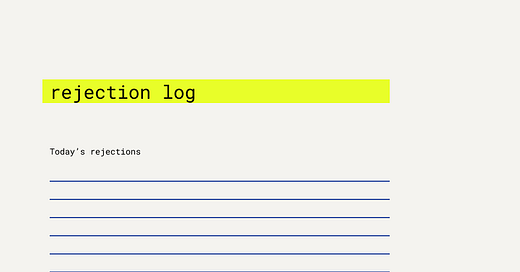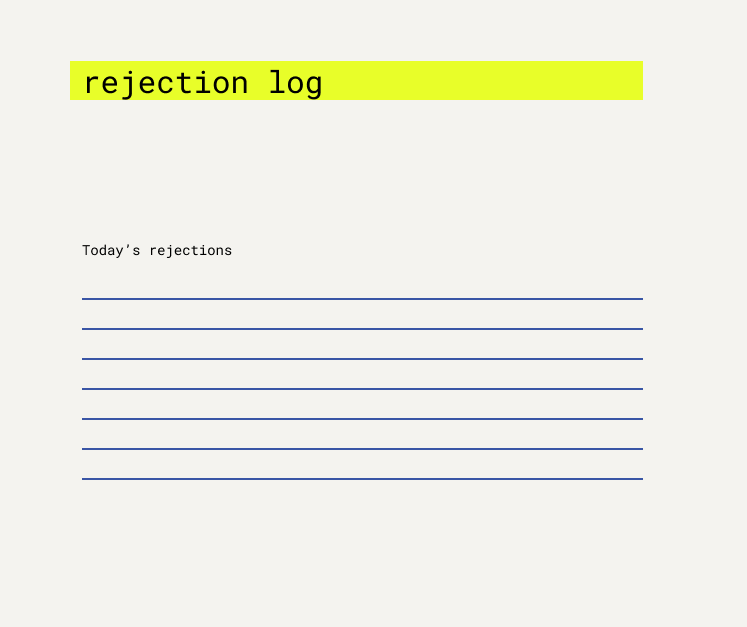Let's set rejection goals in 2025
If you get rejected 50-100 times a week, you’ll have a higher chance at your 2025 vision board
Last week, we talked about goal planning with GPT in 2025 (which, by the way, is now my most popular article!).
Today, we’re closing out the year with a mindset shift:
It may be in your best interest to get rejected — a lot — in 2025.
Rejection is valuable, and ask avoidance is costly. Rejection will get you to your goals, if you can face it emotionally unscathed.
To be rejected, you must ask for something directly. Rejection happens as a result of a direct ask or advance. Ask avoidance, on the other hand, blocks both yeses and nos.
Too many people avoid asking and fail to process the impact of the 0% close rate that comes with not articulating their needs.
Do you face ask avoidance? How many times have you been rejected in the last 24 hours? Week? Month? If the answer doesn’t make you cringe a little, you’re not being rejected enough.
The best outcomes in my life have resulted from direct asks where rejection was a more likely outcome than not. I’ve asked for a spot at MIT for grad school, an extension of my NASA internship, and to formalize starting a company with my co-founders. I’ve asked for business class upgrades (it works), hotel upgrades, free products from companies, and sponsorships for my posts. I’ve asked acquaintances, friends, and strangers to be on my podcast.
Pareto’s Principle shines here: for every ask I’ve made and received, there have been countless others rejected. I didn’t get the TED Fellowship. Forbes 30 Under 30 rejected me. I reached out to dozens of architecture firms after school and heard nothing back. But the cost of those failures is far outweighed by the wins that came from asking.
The upside of rejection is unlimited. Set rejection goals—50 to 100 per week. If you can handle the emotional sting, the downside is minimal.
What Does Rejection Look Like?
Asking for the introduction you’ve been afraid to request
Asking someone you admire for coffee
Posting consistently on social media despite the inevitable lack of validation early on
Asking your boss how you can improve
Reaching out to 100 prospects a week, cold
Chris Voss even suggests asking no-oriented questions to increase your odds of a yes. He says, “The logic is simple: When someone says yes, they’re committing to something, and people are hesitant to make such commitments. On the other hand, when they can say no, they feel protected.” I pulled the paragraph below from his blog. I pulled the paragraph below from his blog.
If you’re new to No-Oriented Questions, it can feel a bit awkward to use them. But once you grow accustomed to them, they will naturally roll off the tongue. Here are a few examples:
Instead of asking: “Do you agree?” Ask: “Do you disagree?”
Instead of asking: “Do you have a few minutes?” Ask: “Is now a bad time to talk?”
Instead of asking: “Does this sound like a good idea?” Ask: “Does this sound like a horrible idea?”
Offer Value
I’m rejected less when my ask addresses someone else’s need.
Here’s an example for content creators reaching out to brands:
Low value:
Hi, I love your stuff. I would love to work with you.
(Inbox fodder)
High value:
Hi, I love what you do and have been using your product. I have a 56% open rate on my Substack, a primarily American/millennial/female audience, and I see that you sponsor newsletters. I’m writing a piece on [related topic], and I’d love to feature you in it. Would you be open to a collaboration?
(This shows you’ve researched their needs, demonstrated relevant value, and made a clear, direct ask.)
Rejection Requires a Direct Ask
A direct ask is not:
“I wanted to check in about…”
“I would love to work on…”
“I wanted to see how you are doing…”
“I love working with you on…”
A direct ask is:
Would you be opposed to working together?
Do you have budget in Q1?
Do you have hesitations about my ability to fulfill this role?
What are the gaps that reduce my chances of [goal]?
Would you be open to chatting with me about the [process]?
Other Benefits of Rejection
Aside from getting what you want more often, rejection has these advantages:
Rejection builds resilience. The more often you’re rejected, the less it stings.
Rejection opens the door to feedback. Once rejected, you have the perfect opportunity to ask what could have been improved for a yes.
Rejection speeds up your failure cycles and increases your odds of success. Research shows that getting rejected increases your chances of success by 50% the next time you ask.
Rejection clarifies priorities. How much did it sting? Did you put your all into the ask?
Rejection develops humility and a growth mindset. You’re not above rejection, but nothing catalyzes growth faster.
Rejection inspires adaptation, urgency, and motivation. After all, rejection inspired Beyoncé to write, “My best revenge is my paper.”
Do you agree? If so, send this to a friend who needs to be rejected more too and leave a comment below.
Rejection planning
How are you getting rejected today? Wishing you a 2025 ripe with rejection—for all the best reasons!
If you liked this article, you may enjoy
The cost of success is embarassment
I was scrolling on TikTok when a creator made me stop in my tracks (or scroll?). She said something so simple yet so profound:







This is such a great POV. I’m working on adding this to my weekly planning.
Great article as always. Thank you! It flips the narrative on rejection and encourages us to embrace it as a stepping stone to growth and success. I really liked your personal examples which bring life to the concept, making it feel tangible and achievable. I especially loved the reframing of rejection goals and how they can speed up failure cycles to increase our odds of success. It’s a mindset shift many of us need.
But as empowering as this idea is, I think it’s important to acknowledge why rejection can be so hard for many people. It’s not just about the "no." Rejection often triggers deep-seated fears of inadequacy, self-doubt, and even shame. Many of us have an inner critic that turns a single rejection into a sweeping narrative of personal failure. For those struggling with this, stepping into the world of "ask and get rejected often" can feel emotionally overwhelming.
This is where balancing rejection with reflection becomes crucial. Setting rejection goals is powerful, but it’s just as important to pause and process what happens after each "no." Did the rejection sting more than expected? Why? Was it tied to a specific fear or belief about your abilities? Reflection helps untangle these emotions and narratives, making it easier to bounce back and try again.
A big part of this reflection involves your inner dialogue. When faced with rejection, our instinct might be self-criticism: "I’m not good enough," or "Why did I even try?" But this is where reframing becomes essential. Instead of, "I failed," try, "This wasn’t the right fit, but I’ll learn from it." By addressing the stories we tell ourselves, we can move from self-doubt to self-compassion. Tools like journaling, mindfulness, or even having a mantra like "Every 'no' brings me closer to a 'yes'" can counteract that inner critic and help us build resilience over time.
Lastly, rejection isn’t a one-size-fits-all experience. For some, cultural or personal upbringing might make rejection feel especially daunting. Addressing these unique challenges requires empathy, both for ourselves and others. It’s not just about being brave; it’s about being kind to ourselves as we learn to navigate this new mindset.
Thank you again for highlighting this thought-provoking topic.